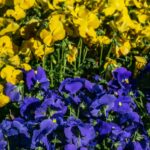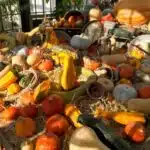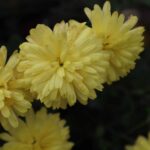For those who reside in cold climates, gardening can be a challenging task. However, with the right knowledge and selection of plants, it is entirely possible to have a flourishing garden even in frosty temperatures. If you are looking for fun and low-maintenance plants that can survive the harsh winter months, then look no further. In this article, we will discuss the 11 best fun plants to grow in cold climates.
These plants offer an excellent opportunity to add color and life to your garden during the colder months of the year. Whether you are a seasoned gardener or someone who is just starting out, these plants are easy to maintain and will add beauty to your outdoor space. With their unique features and hardy nature, each plant on this list has something different to offer, whether it is vibrant foliage or fragrant flowers. So let’s dive into some of the best fun plants to grow in cold climates and start creating a beautiful winter garden that everyone can enjoy!
Hardy Cyclamen
What are the best plants to grow in cold climates? One plant that should definitely be on your list is the hardy cyclamen. As a specialist in plants for cold climates, I can attest to the many benefits of growing this gorgeous plant.
Firstly, growing hardy cyclamen is relatively easy with proper care and attention. These perennial plants thrive in moist, well-drained soil and prefer partial shade or filtered sunlight. They don’t require much fuss, making them ideal for those who are new to gardening or have less time to devote to their plants.
In addition to being low-maintenance, hardy cyclamen offer a range of benefits beyond their stunning appearance. They bloom in late winter or early spring when few other flowers are around, brightening up any garden with their delicate petals and striking colors. Plus, they’re great for attracting pollinators like bees and butterflies. With these growing tips and benefits in mind, it’s no wonder why hardy cyclamen are a popular choice among gardeners in colder regions.
Moving on from hardy cyclamen, let’s delve into another beautiful plant that thrives in cold climates: hellebores.
Hellebores
Hardy Cyclamen is a delightful plant that can thrive in cold climates. Its exquisite flowers bloom from autumn to winter, adding a touch of color to any garden. However, if you are looking for something with more evergreen foliage, then Hellebores might be the perfect fit for your garden.
Hellebores are known for their stunning flowers that bloom in late winter or early spring. Their unique and intricate petals come in various colors, ranging from white to pink, purple, and even green. They are an excellent choice for those who want to add some beauty to their garden during the colder months.
The beauty of hellebores lies not only in their flowers but also in their evergreen leaves. They can grow up to two feet tall and three feet wide and can survive temperatures as low as -20°F. Moreover, they are relatively easy to care for and propagate. If you want to learn how to propagate hellebores, read on for a step-by-step guide on how to do it successfully!
Winter Jasmine is another plant that thrives in cold climates and can add some much-needed color during the winter months. Its bright yellow flowers bloom from December all the way through March, making it an excellent addition to any garden. If you’re interested in learning more about this beautiful plant, read on!
Winter Jasmine
Winter Jasmine (Jasminum nudiflorum) is a hardy deciduous shrub native to Northern China and Korea. It is tolerant of temperatures as low as -20 degrees Celsius, making it ideal for cultivation in cold climates. Its vivid yellow flowers appear in winter and provide a sweet fragrance to the cold air. When grown in its preferred sunny spot, with well-drained soil, it can form a large bush of up to 3 meters in height and width.
Cultivation
When it comes to cultivating winter jasmine in cold climates, there are several tips for ensuring success. First and foremost, it’s important to choose a location that provides ample sunlight, as winter jasmine requires plenty of light to thrive. Additionally, gardeners should ensure that the soil is well-draining and fertile, as this will help to prevent waterlogging and promote healthy growth.
To maintain healthy winter jasmine plants in cold weather, it’s important to follow best practices for pruning and fertilization. Pruning should be done in early spring or late fall, before the plant enters its dormant phase. This will promote new growth and help to keep the plant looking neat and tidy. Fertilization should be done sparingly during the growing season, with a focus on providing balanced nutrients rather than overfeeding.
Overall, winter jasmine is a hardy and rewarding plant to grow in cold climates. By following these tips for successful cultivation and best practices for maintaining healthy plants in cold weather, gardeners can enjoy vibrant blooms and lush foliage throughout the winter months. With a little care and attention, this beautiful plant can provide joy and beauty even during the dreariest of seasons.
Fragrance
As plant enthusiasts explore the aromatic varieties of winter jasmine, they discover that these shrubs can be more than just a pretty sight. Winter jasmine is known for its sweet fragrance, which is often described as delicate and soothing. This makes it an excellent choice for creating fragrant container gardens or adding a touch of scent to outdoor spaces.
To fully enjoy the fragrance of winter jasmine, gardeners should consider planting it in areas where people frequently pass by or sit. This way, the scent can be appreciated up close and personal. In cold climates where winters can be harsh and dreary, the sweet fragrance of winter jasmine brings a much-needed boost to the senses.
For those who are interested in winter jasmine solely for its fragrance, there are certain cultivars that produce more pronounced scents than others. Gardeners should do their research and select cultivars that have been specifically bred for their fragrant qualities. By choosing the right variety and planting it in optimal conditions, gardeners can enjoy not only the beauty but also the delightful aroma of this hardy plant in cold climates.
Snowdrops
Snowdrops are one of the most cherished plants for gardeners who live in cold climates. These small, delicate white flowers are some of the earliest blooming flowers of spring. Snowdrops grow best in moist soil with good drainage, and they can thrive in full sunlight or partial shade. They prefer colder weather, but they will also grow well in areas with mild winters.
Uses for snowdrops in landscaping are numerous, and they’re often used as a border plant or an accent plant. Snowdrops pair well with other early-blooming plants such as crocuses and daffodils. They can also be used to fill in bare spots around trees or shrubs, and they make a lovely addition to rock gardens. Snowdrops have even been known to naturalize over time, creating a beautiful carpet of white blooms.
Growing snowdrops in containers is another option for gardeners who want to enjoy these lovely flowers indoors or on their patios. When planting snowdrops in containers, use soil that has good drainage and keep the soil moist but not wet. Place the container in an area that receives plenty of sunlight during the day but is protected from strong winds. With proper care, snowdrop bulbs will bloom beautifully year after year.
As winter fades away and spring begins to emerge, gardeners eagerly anticipate the arrival of these charming little flowers. However, there are many other cold-hardy plants that can add color and interest to your landscape during this transitional period. One such plant is witch hazel.
Witch Hazel
- Witch Hazel is a deciduous shrub or small tree that is native to North America, Europe and parts of Asia.
- It is valued for its yellow, orange or red flowers, which are often among the earliest to appear in the cold winter months.
- Witch Hazel is used medicinally as a topical astringent for minor skin irritations, and has been used for centuries for its antiseptic and anti-inflammatory properties.
- Witch Hazel is an easy-care plant and can be grown in full sun or partial shade.
- It tolerates a range of soils and prefers a slightly acidic pH.
- Pruning should be done in late winter to ensure optimal blooming the following year.
Uses
Looking for a plant that can thrive in cold climates and add a touch of fun to your indoor gardening? Look no further than the witch hazel. This unique plant is not only beautiful, but also has a variety of uses.
Witch hazel can be used to create a creative indoor garden display. Its delicate, spidery flowers bloom in late winter or early spring, bringing color and life to any room. It’s also easy to care for and doesn’t require much space, making it ideal for those with limited room or time.
Beyond its ornamental value, witch hazel also has benefits for mental health. Studies have shown that gardening can reduce stress and anxiety while improving overall well-being. So why not cultivate some witch hazel plants and enjoy the therapeutic benefits they bring?
In summary, witch hazel is a great choice for those looking to add some fun and beauty to their indoor garden while reaping the many benefits of gardening for mental health. Whether you’re an experienced gardener or just starting out, this versatile plant is sure to delight and inspire.
History
Witch hazel is not only a beautiful and useful plant, but it also has a fascinating history. This plant has been used for medicinal purposes for centuries by Native Americans and early European settlers. Its bark, leaves, and twigs were boiled to create an astringent that was used to treat skin inflammation, wounds, and hemorrhoids.
As climate change continues to impact the world, it’s important to understand the evolution of cold climate plant species like witch hazel. The witch hazel genus originated in eastern Asia and North America during the Eocene epoch, which lasted from about 56 million to 33.9 million years ago. Over time, these plants adapted to colder climates by developing features such as tough foliage and deep roots that can withstand freezing temperatures.
Today, witch hazel remains a popular choice for indoor gardening in cold climates due to its hardiness and versatility. By learning about its history and evolution, we can appreciate the unique qualities of this plant even more. As we continue to navigate the challenges posed by climate change, it’s important to support sustainable gardening practices that help preserve the natural world around us.
Care
Indoor vs outdoor care is an essential factor that determines the health and growth of witch hazel plants, especially in cold climates. When grown indoors, it’s important to provide ample sunlight and well-drained soil for optimal growth. These plants require moderate watering and should be kept away from drafts and extreme temperatures. On the other hand, when grown outdoors, witch hazel plants do well in full sun to partial shade with well-draining soil. It’s crucial to monitor the moisture level of the soil regularly and maintain a consistent watering schedule.
During winter months, proper care is necessary to ensure the survival of witch hazel plants in cold climates. One tip for winter plant care is to mulch around the base of the plant to protect its roots from freezing temperatures. Another helpful tip is to avoid over-watering during this time as waterlogged soil can lead to root rot. Additionally, pruning should be done during late winter or early spring before new growth appears.
Overall, caring for witch hazel in cold climates requires attention to detail and a deep understanding of their unique needs. By providing proper indoor or outdoor care and following these tips for winter plant care, gardeners can enjoy the beauty and medicinal benefits of this fascinating plant all year round.
Winterberry
Winterberry, also known as Ilex verticillata, is a stunning plant that can add a pop of color to any garden or landscape. This deciduous holly plant is native to North America and is well-known for its bright red berries that appear in the fall and winter months. The berries are a favorite among birds and other wildlife, making it an excellent addition to any garden that aims to attract wildlife.
Uses for Winterberry include holiday decor and natural dye. The bright red berries make a beautiful addition to holiday wreaths, garlands, and centerpieces. Additionally, the berries can be used as a natural dye for fabrics and other materials. Winterberry is an excellent choice for those who want to incorporate natural elements into their home decor.
Growing Winterberry requires some tips and tricks for cold climates. It is important to note that this plant prefers moist soil conditions, so be sure to keep the soil consistently moist throughout the growing season. Additionally, pruning should be done in late winter or early spring before new growth appears. Lastly, it is crucial to plant male pollinators nearby because female plants require pollen from male flowers to produce fruit.
Next up on our list of fun plants to grow in cold climates are pansies. These colorful flowers are perfect for adding a touch of beauty to any garden or landscape during the colder months. With proper care and attention, pansies can bloom all winter long, providing a much-needed burst of color during drab winter days.
Pansies
Pansies are one of the best plants to grow in cold climates due to their durability and beauty. These flowers come in a variety of colors, making them ideal for landscaping purposes. Pansies can be used as borders or planted en masse to create a beautiful display. They are also perfect for containers and window boxes, adding color and interest to any outdoor space.
The benefits of pansies for landscaping are numerous. Besides their vibrant colors, they are easy to care for, making them a popular choice among gardeners. Pansies thrive in cool weather conditions and can withstand frost and snow. They also attract pollinators such as bees and butterflies, making them an excellent addition to any garden.
Creative ways to use pansies in DIY projects include creating beautiful floral arrangements or using them to decorate cakes and other desserts. Pansies can also be used as natural dye sources for fabrics or paper crafts due to their bright pigments. With their versatility, pansies are not just limited to outdoor gardening but can also be incorporated into various art forms.
Transitioning into the subsequent section about violas, another flowering plant that thrives in cold climates is violas. Like pansies, violas come in many different colors and make great additions to any garden or container arrangement.
Violas
Violas: Edible or Ornamental? That is the question that many gardeners ask themselves when choosing these plants for their garden. The answer is both! Violas are not only beautiful ornamental plants, but they are also edible and can be used to add color and flavor to salads, desserts, and even cocktails.
Growing Violas in Containers or in the Ground? The choice is yours! Violas are versatile plants that can thrive in a variety of growing conditions. They do well in containers, making them perfect for small space gardening or for adding color to patios and balconies. Alternatively, they can also be planted directly into the ground in flower beds or borders.
Violas are easy to care for and require little maintenance. They prefer cooler temperatures and can tolerate light frosts, making them an excellent choice for cold climates. With regular watering and occasional fertilization, violas will bloom all season long, providing a pop of color to any garden.
Transitioning into the subsequent section about ‘ornamental kale’, another cold-hardy plant option for gardens in chilly climates is ornamental kale. Like violas, ornamental kale is both beautiful and edible. Let’s take a closer look at this unique plant and how it can be incorporated into your garden design.
Ornamental Kale
Violas are a great choice for adding a splash of color to your garden, but if you’re looking for something more substantial, ornamental kale might be just what you need. These hardy plants are perfect for cold climates and come in a variety of unique varieties that can add texture and interest to any garden.
One of the best things about ornamental kale is that it’s not just pretty to look at – it’s also edible! Kale chips have become a popular snack in recent years, and making them at home couldn’t be easier. Simply remove the leaves from the stem, toss them with olive oil and salt, and bake them in the oven until crispy. You can also incorporate kale into soups and stews for a healthy winter meal.
If you’re looking for more ways to use your ornamental kale, there are plenty of delicious recipes to try. From hearty winter salads to savory quiches, there’s no shortage of ways to enjoy this versatile green. And with its vibrant colors and unique shapes, it’s sure to be a talking point at any dinner party or potluck.
As much as we love ornamental kale, there are still plenty of other fun plants to grow in cold climates. One such plant is the camellia, which is known for its beautiful flowers that bloom in shades of pink and red throughout the winter months. Whether you’re looking for an eye-catching centerpiece for your garden or simply want to brighten up your windowsill on a dreary winter day, camellias are an excellent choice. So why not add one (or several!) to your collection this year?
Camellias
Camellias are a beautiful and hardy plant that can thrive in cold climates. These plants are known for their unique and vibrant flowers, which come in a variety of colors and sizes. Camellias are often used as ornamental plants, but they can also be grown for their tea leaves, which are used to make a popular beverage in many parts of the world.
Caring for Camellias: Tips and Tricks To ensure that your camellias thrive in cold climates, it is important to provide them with the right care. Camellias prefer moist soil that is well-draining, so it is important to water them regularly. Additionally, these plants require regular fertilization to promote healthy growth and blooming. During the winter months, it is important to protect camellias from frost by covering them with burlap or other protective materials.
Unique Camellia Varieties to Try There are many unique varieties of camellias available that can add beauty and interest to your garden. Some popular varieties include the Japonica Camellia, which has large flowers in shades of pink and red, and the Sasanqua Camellia, which has smaller flowers in shades of white and pink. Other unique varieties include the Higo Camellia, which has ruffled petals that give it a unique appearance, and the Yuletide Camellia, which blooms during the winter months.
Overall, camellias are an excellent choice for those looking to add some color and interest to their garden in cold climates. With proper care and attention, these beautiful plants can thrive for many years to come. Whether you choose a traditional variety or something more unique, camellias are sure to delight with their vibrant blooms and hardy nature.
Conclusion
As a plant expert for cold climates, I highly recommend growing the following 11 fun plants to add color and life to your winter garden: Hardy Cyclamen, Hellebores, Winter Jasmine, Snowdrops, Witch Hazel, Pansies, Violas, Ornamental Kale, Camellias.
These plants are not only beautiful but also hardy enough to survive the harsh conditions of winter. Hardy Cyclamen and Hellebores are perfect for adding pops of pink and purple to your garden while Winter Jasmine and Witch Hazel will bring in a burst of yellow. Snowdrops are delicate blooms that will add a touch of elegance to your winter landscape.
Pansies and Violas come in an array of colors and can be planted in pots or flower beds. Ornamental Kale is another great option for adding texture and color to your garden. Finally, Camellias are stunning evergreen shrubs with large blooms that will brighten up any winter day.
In conclusion, growing these 11 fun plants in cold climates is an excellent way to add beauty and interest to your winter garden. Each plant offers something unique, from vibrant colors to delicate textures. By incorporating these plants into your landscape design, you’ll create a beautiful and inviting space that you can enjoy year-round. So why not take advantage of the many benefits these plants have to offer?
Image Credits
- “Insular Ice and Cold Storage Plant in the final stage of completion, Manila, Philippines, 1901-1910” by J. Tewell (featured)





























